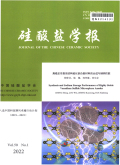硅酸盐学报2024,Vol.52Issue(7):2232-2242,11.DOI:10.14062/j.issn.0454-5648.20230552
二维六方Mo2B2作为金属离子电池负极材料的第一性原理研究
First Principles Study of Two-Dimensional h-Mo2B2 as a Negative Electrode for Metal-Ion Batteries
摘要
Abstract
Introduction With the continuous growth in energy storage demands for portable electronic devices,electric vehicles,and grid energy storage,rechargeable metal-ion batteries have found extensive applications in energy supply and storage due to their advantages of low self-discharge,high energy density,and environmental friendliness.One of the essential components of metal-ion batteries is the negative electrode material,and its physical and chemical properties are crucial for battery performance.However,in practical applications,there is still a shortage of high-performance negative electrode materials for metal-ion batteries.Traditional three-dimensional electrode materials suffer from limited storage capacity and less than ideal charge-discharge rates,primarily because of the limited number of lattice vacancies in their structure.This limitation hinders their ability to meet market demands,particularly in scenarios where faster charge-discharge rates are required,such as electric vehicles and grid energy storage.In contrast,two-dimensional materials offer advantages such as a larger specific surface area and enhanced metal ion diffusion,making them suitable for energy storage in batteries.Among two-dimensional materials,the emerging class of two-dimensional transition metal borides(MBenes)exhibits excellent electrical conductivity,structural stability,and high specific capacity.As a result,an increasing amount of research work is considering them as electrode materials for energy storage systems.Compared to traditional experimental research methods,first-principles computational techniques can better assist in designing novel high-performance electrode materials at the atomic and electronic scale.In this paper,we aim to explore the potential of h-Mo2B2 MBene as a negative electrode material for metal-ion batteries using first-principles calculation methods.We systematically investigate its structural stability,electronic structure,and electrochemical properties.The studies suggest that h-Mo2B2 holds promise as a prospective negative electrode material for application in metal-ion batteries. Methods In this paper the calculations are based on Density Functional Theory(DFT)first-principles methods,implemented using the Vienna Ab initio Simulation Package(VASP).The Projector Augmented Wave(PAW)pseudopotential approach is utilized,with a plane wave cutoff energy of 500 eV.The Perdew-Burke-Ernzerhof(PBE)generalized gradient approximation(GGA)is employed for the exchange-correlation functional.To account for the interaction between metal cations and 2D materials,van der Waals interactions are considered in the calculations.During the geometric structure optimization,energy and force convergence criteria are set to 10-5 eV/atom and 0.01 eV/Å,respectively.The K-point grids used for h-Mo2B2 unit cell and 2×2×1 supercell calculations are 20×20×1 and 5×5×1,respectively.A vacuum layer with a thickness of 20 Å is included to eliminate the spurious interaction.Phonon spectra calculations are performed using density functional perturbation theory.Differential charge calculations are employed to study charge redistribution and transfer between adsorbed metal atoms and 2D materials.Bader charge analysis is utilized to assess the amount of charge transfer between the metal ions and the 2D material.The Climbing Image Nudged Elastic Band(CI-NEB)method is used to calculate the migration energy barriers and migration pathways of metal ions on h-Mo2B2. Results and discussion The 2D h-Mo2B2 studied in this paper belongs to the P6/mmm space group within the hexagonal crystal system.It comprises three atomic layers stacked in a Mo-B-Mo sequence,with hexagonal B atomic layers situated between the upper and lower Mo atomic planes.To evaluate the dynamical stability of h-Mo2B2,phonon spectrum calculations were conducted,and no imaginary frequencies were observed throughout the entire Brillouin zone.This indicates that h-Mo2B2 exhibits dynamical stability.The band structure of h-Mo2B2 reveals numerous bands crossing the Fermi level,confirming its metallic nature.This exceptional electrical conductivity of h-Mo2B2 can significantly enhance the rate performance of electrodes.Adsorption energy is a fundamental criterion for assessing whether a material can be utilized as a negative electrode.The adsorption energies of Li,Na,Mg,and K on the h-Mo2B2 surface were calculated,and all exhibited negative values,indicating effective adsorption of all metal atoms on a monolayer of h-Mo2B2.Rapid charge-discharge rates are crucial for secondary batteries,and the migration energy barrier of metal ions is a key factor determining the charge-discharge rate.The migration energy barriers for the four metal atoms on the h-Mo2B2 surface are ranked as K(7 meV)<Na(10 meV)<Mg(37 meV)<Li(39 meV).The extremely low migration energy barriers suggest that Li,Na,Mg,and K can easily diffuse on h-Mo2B2,making it a promising high-rate electrode material.As a negative electrode material for lithium-ion batteries,h-Mo2B2 exhibits a theoretical specific capacity of 735 mA·h·g-1,significantly surpassing graphite's 372 mA·h·g-1.For sodium ion,h-Mo2B2 boasts a theoretical specific capacity of 314 mA·h·g-1,while for magnesium ion,due to multilayer adsorption and divalent ions carrying more charge,it reaches 1 506 mA·h·g-1,far exceeding the capacity for Li and Na.Theoretical calculations also indicate that h-Mo2B2 possesses low average open-circuit voltages of 0.36 V(Li),0.47 V(Na),and 0.63 V(Mg),all within the 0-1 V range.This lowers the likelihood of dendrite formation in the negative electrode,thereby enhancing the safety and stability of metal-ion batteries.This paper,from a theoretical standpoint,elucidates and confirms the potential of h-Mo2B2 as a negative electrode material for rechargeable metal-ion batteries.It paves the way and provides valuable insights for the design of high-performance electrode materials. Conclusions Based on first-principles calculations,we systematically investigated the physical properties and electrochemical performance of 2D h-Mo2B2 MBene.It was found that h-Mo2B2 is dynamically stable and exhibits metallic conductivity.The diffusion barriers for metal atoms(M=Li,Na,Mg,K)on h-Mo2B2 are remarkably low,all being less than 0.04 eV,indicating that h-Mo2B2 can facilitate rapid charge and discharge when employed as a negative electrode material in metal-ion batteries.The theoretical specific capacities of h-Mo2B2 for Li,Na,and Mg are 753,314,and 1 506 mA·h·g-1,respectively.Furthermore,the average open-circuit voltages(OCV)for h-Mo2B2 with Li,Na,and Mg are calculated to be 0.36,0.47,and 0.63 V,respectively.All these findings collectively support that 2D h-Mo2B2 MBene can serve as a high-performance negative electrode material for lithium,sodium,and magnesium ion batteries.关键词
第一性原理计算/金属离子电池/负极材料/二维过渡金属硼化物Key words
first-principles calculation/metal ion battery/negative electrode material/two-dimensional transition metal borides分类
化学工程引用本文复制引用
曹宇,张国辉,王长刚,周静,蔡永茂,赵耀..二维六方Mo2B2作为金属离子电池负极材料的第一性原理研究[J].硅酸盐学报,2024,52(7):2232-2242,11.基金项目
国家自然科学基金(52172185) (52172185)
吉林省教育厅科学技术研究项目(JJKH20210084KJ) (JJKH20210084KJ)
吉林市科技创新发展计划(20230103006) (20230103006)
吉林省创新创业人才资助项目(2022QN15). (2022QN15)

